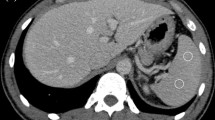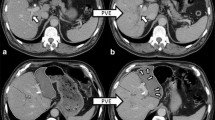Abstract
Purpose
To identify post-liver transplant CT findings which predict graft failure within 1 year.
Materials and methods
We evaluated the CT scans of 202 adult liver transplants performed in our institution who underwent CT within 3 months after transplantation. We recorded CT findings of liver perfusion defect (LPD), parenchymal homogeneity, and the diameters and attenuations of the hepatic vessels. Findings were correlated to 1-year graft failure, and interobserver variability was assessed.
Results
Forty-one (20.3%) of the 202 liver grafts failed within 1 year. Graft failure was highly associated with LPD (n = 18/25, or 67%, versus 15/98, or 15%, p < 0.001), parenchymal hypoattenuation (n = 20/41, or 48.8% versus 17/161, or 10.6%, p < 0.001), and smaller diameter of portal veins (right portal vein [RPV], 10.7 ± 2.7 mm versus 14.7 ± 2.2 mm, and left portal vein [LPV], 9.8 ± 3.0 mm versus 12.4 ± 2.2 mm, p < 0.001, respectively). Of these findings, LPD (hazard ratio [HR], 5.43, p < 0.001) and small portal vein diameters (HR, RPV, 3.33, p < 0.001, and LPV, 3.13, p < 0.05) independently predicted graft failure. All the measurements showed fair to moderate interobserver agreement (0.233~0.597).
Conclusion
For patients who have CT scan within the first 3 months of liver transplantation, findings of LPD and small portal vein diameters predict 1-year graft failure.
Key Points
•Failed grafts are highly associated with liver perfusion defect, hypoattenuation, and small portal vein.
•Right portal vein < 11.5 mm and left portal vein < 10.0 mm were associated with poor graft outcome.
•Liver perfusion defect and small portal vein diameter independently predicted graft failure.





Similar content being viewed by others
Abbreviations
- AUC:
-
Areas under the curve
- CCC:
-
Concordance correlation coefficient
- CI:
-
Confidence interval
- HR:
-
Hazard ratio
- HV:
-
Hepatic vein
- IVC:
-
Inferior vena cava
- LPD:
-
Liver perfusion defect
- LPV:
-
Left portal vein
- MELD:
-
Model for end-stage liver disease
- OLT:
-
Orthotopic liver transplantation
- OR:
-
Odds ratio
- PACS:
-
Picture archiving and communication system
- ROC:
-
Receiver operating characteristic
- RPV:
-
Right portal vein
References
Alqahtani SA, Larson AM (2011) Adult liver transplantation in the USA. Curr Opin Gastroenterol 27:240–247
(2010) Abstracts of the 16th Annual International Congress of the International Liver Transplantation Society. June 16-19, 2010. Hong Kong, China. Liver Transpl 16 Suppl1:S69-S263
Bower WA, Johns M, Margolis HS, Williams IT, Bell BP (2007) Population-based surveillance for acute liver failure. Am J Gastroenterol 102:2459–2463
Grossman EJ, Millis JM (2010) Liver transplantation for non-hepatocellular carcinoma malignancy: indications, limitations, and analysis of the current literature. Liver Transpl 16:930–942
Elion GB (1989) The purine path to chemotherapy. Science 244:41–47
Kim WR, Stock PG, Smith JM et al (2013) OPTN/SRTR 2011 annual data report: liver. Am J Transplant 13(Suppl 1):73–102
Wagener G, Raffel B, Young AT, Minhaz M, Emond J (2013) Predicting early allograft failure and mortality after liver transplantation: the role of the postoperative model for end-stage liver disease score. Liver Transpl 19:534–542
Mourad MM, Liossis C, Gunson BK et al (2014) Etiology and management of hepatic artery thrombosis after adult liver transplantation. Liver Transpl 20:713–723
Varotti G, Grazi GL, Vetrone G et al (2005) Causes of early acute graft failure after liver transplantation: analysis of a 17-year single-centre experience. Clin Transplant 19:492–500
Kim JS, Kwon JH, Kim KW et al (2018) Low graft attenuation at unenhanced CT: association with 1-month mortality or graft failure after liver transplantation. Radiology 287:167–175
Croome KP, Wall W, Quan D et al (2012) Evaluation of the updated definition of early allograft dysfunction in donation after brain death and donation after cardiac death liver allografts. Hepatobiliary Pancreat Dis Int 11:372–376
Olthoff KM, Kulik L, Samstein B et al (2010) Validation of a current definition of early allograft dysfunction in liver transplant recipients and analysis of risk factors. Liver Transpl 16:943–949
Briceno J, Ciria R (2010) Early graft dysfunction after liver transplantation. Transplant Proc 42:631–633
Busuttil RW, Tanaka K (2003) The utility of marginal donors in liver transplantation. Liver Transpl 9:651–663
Singh AK, Nachiappan AC, Verma HA et al (2010) Postoperative imaging in liver transplantation: what radiologists should know. Radiographics 30:339–351
Friedewald SM, Molmenti EP, DeJong MR, Hamper UM (2003) Vascular and nonvascular complications of liver transplants: sonographic evaluation and correlation with other imaging modalities and findings at surgery and pathology. Ultrasound Q 19:71–85 quiz 108-110
Kim JS, Kwon JH, Kim KW et al (2016) CT features of primary graft nonfunction after liver transplantation. Radiology 281:465–473
Akamatsu N, Sugawara Y, Satou S et al (2014) Hemodynamic changes in the hepatic circulation after the modulation of the splenic circulation in an in vivo human experimental model. Liver Transpl 20:116–121
Sanada Y, Mizuta K, Urahashi T et al (2011) Hepatic arterial buffer response after pediatric living donor liver transplantation: report of a case. Transplant Proc 43:4019–4024
Kelly DM, Zhu X, Shiba H et al (2009) Adenosine restores the hepatic artery buffer response and improves survival in a porcine model of small-for-size syndrome. Liver Transpl 15:1448–1457
Hashimoto K, Miller CM, Quintini C et al (2010) Is impaired hepatic arterial buffer response a risk factor for biliary anastomotic stricture in liver transplant recipients? Surgery 148:582–588
Anders M, Alvarez D, Quiñonez E et al (2014) A hemodynamic study to evaluate the buffer response in cirrhotic patients undergoing liver transplantation. ISRN Transpl 2014:757910
Jang JK, Kim KW, Choi SH et al (2019) CT of acute rejection after liver transplantation: a matched case-control study. Eur Radiol 29:3736–3745
Cirera I, Navasa M, Rimola A et al (2000) Ascites after liver transplantation. Liver Transpl 6:157–162
Navasa M, Feu F, Garcia-Pagan JC et al (1993) Hemodynamic and humoral changes after liver transplantation in patients with cirrhosis. Hepatology 17:355–360
Gadano A, Hadengue A, Widmann JJ et al (1995) Hemodynamics after orthotopic liver transplantation: study of associated factors and long-term effects. Hepatology 22:458–465
Davenport MS, Khalatbari S, Cohan RH, Dillman JR, Myles JD, Ellis JH (2013) Contrast material-induced nephrotoxicity and intravenous low-osmolality iodinated contrast material: risk stratification by using estimated glomerular filtration rate. Radiology 268:719–728
Acknowledgments
We would like to give special thanks to Yu-Ching Chou, associate professor in National Defense Medical Center, for his statistics expert and help.
Funding
This study has received funding by study project of Tri-Service General Hospital (TSGH-C108-055).
Author information
Authors and Affiliations
Corresponding author
Ethics declarations
Guarantor
The scientific guarantor of this publication is Associate Professor Dr. Wei-Chou Chang.
Conflict of interest
The authors of this manuscript declare no relationships with any companies whose products or services may be related to the subject matter of the article.
Statistics and biometry
Associate Professor Yu-Ching Chou is a statistics expert and gave us several advices in the statistics.
Informed consent
Written informed consent was waived by the Institutional Review Board.
Ethical approval
Institutional Review Board approval was obtained by University of San Francisco (12-10492 and 18-26242).
Methodology
•Retrospective
•Diagnostic or prognostic study
•Performed at one institution
Additional information
Publisher’s note
Springer Nature remains neutral with regard to jurisdictional claims in published maps and institutional affiliations.
Electronic supplementary material
ESM 1
(DOCX 257 kb)
Rights and permissions
About this article
Cite this article
Chang, WC., M. Yeh, B., Chu, L. et al. Post-operative assessment in patients after liver transplantation: imaging parameters associated with 1-year graft failure. Eur Radiol 31, 764–774 (2021). https://doi.org/10.1007/s00330-020-07124-w
Received:
Revised:
Accepted:
Published:
Issue Date:
DOI: https://doi.org/10.1007/s00330-020-07124-w




